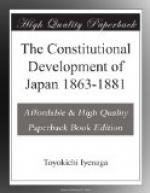[Footnote 1: The Mikado’s Empire. Griffis, p. 301.]
[Footnote 2: American Executive Document, Diplomatic Correspondence, 1867, Part Ii., p. 78, 2d Sess. 40th Cong. See also Bosin-Simatsu, Vol. I., p. 2.]
[Footnote 3: American Executive Document, Diplomatic Correspondence, Vol. I., 1868-69, p. 620, 3d Sess. 40th Cong.]
[Footnote 4: American Executive Document, Diplomatic Correspondence, Vol. I., 1868-69, 3d Sess. 40th Cong.]
[Footnote 5: Translation from the Kioto Government Gazette of March, 1868. It is given in Diplomatic Correspondence of the U.S.A., 3d Sess. 40th Cong., Vol. I, 1868-69, p. 725.]
[Footnote 6: He afterwards changed his name into Toshimitsu Okubo.]
[Footnote 7: Translation is given in American Executive Document, Diplomatic Correspondence, Vol. I, 1868-69, p. 728, 3d Sess. 40th Cong.]
[Footnote 8: American Executive Document, Diplomatic Correspondence, Vol. I., 1868-69, p. 687, 3d Sess. 40th Cong.]
[Footnote 9: F.O. Adams’ History of Japan, Vol. Ii., p. 128.]
[Footnote 10: English State Papers, Vol. LXX., 1870, p. 9.]
[Footnote 11: 29th of the 2d month in the second year of Meiji, according to the old calendar.]
[Footnote 12: Translation is given in English State Papers, Vol. LXX., 1871, p. 12.]
CHAPTER III.
The abolition of feudalism.
The measure to abolish feudalism was much discussed in the Kogisho before its dissolution. Prince Akidzuki, President of the Kogisho, had sent in the following memorial:
“After the government had been returned by the Tokugawa family into the hands of the Emperor, the calamity of war ensued, and the excellence of the newly established administration has not yet been able to perfect itself; if this continues, I am grieved to think how the people will give up their allegiance. Happily, the eastern and northern provinces have already been pacified and the country at large has at last recovered from its troubles. The government of the Emperor is taking new steps every day; this is truly a noble thing for the country. And yet when I reflect, I see that although there are many who profess loyalty, none have yet shown proof of it. The various princes have used their lands and their people for their own purposes; different laws have obtained in different places; the civil and criminal codes have been various in the various provinces. The clans have been called the screen of the country, but in truth they have caused its division. The internal relations having been confused, the strength of the country has been disunited and severed. How can our small country of Japan enter into fellowship with the countries beyond the sea? How can she hold up an example of a flourishing country? Let those who wish to show their faith and loyalty act in the following manner, that they may firmly establish the foundations of the Imperial Government:




